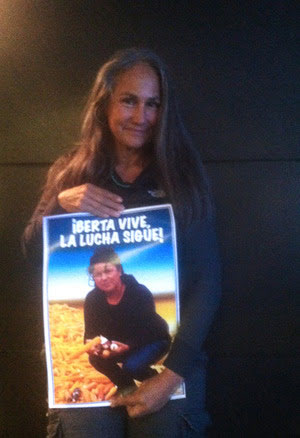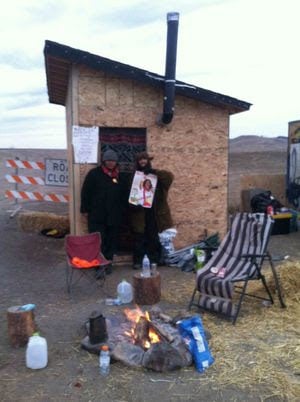Around the globe, land has become gold-standard currency. As a result, Indigenous and other land-based peoples face threats to the natural commons on which they live, produce food and sustain community, culture and cosmovision.
In some places, organized Indigenous movements have stood up and fought off extraction and corporate development, winning protection of waters, forests, territories and more. In most places, the resistance has been met with assassination and violent repression by state security forces and corporate-financed hit squads.
Two of the fiercest Native battles in the Americas today are closely connected. They are led by the Standing Rock Sioux in North Dakota and by the Lenca people in Honduras, organized through the Civic Council of Popular and Indigenous Organizations of Honduras (COPINH). Both are hard at work defending their territories and waters from further theft and desecration: At Standing Rock they are struggling against an oil pipeline being laid under their ancestral Missouri River, which they use for ceremony, drinking water and sustaining other life; on Lenca lands they are resisting the damming of their ancestral Gualcarque and other rivers.
 Eightball, age 13, is a proud Native from New Mexico. His favorite activities are participating in his people’s ancient ceremonies and playing games on his cell phone. This was his first political action, and he longed to forgo the rest of seventh grade to remain at Standing Rock. The letters “DAPL” on the board appended to the highway sign refer to the Dakota Access pipeline. (Credit: Beverly Bell)In both cases, the movements face enormous stakes. And they both know that, as Howard Zinn said, “The power of the people on top depends on the obedience of the people below.” So they are challenging the power on top with shared strategies of mass mobilization and direct action. They both have the capacity to inspire the world, as seen by an outpouring of active solidarity with their uprisings from around the globe.
Eightball, age 13, is a proud Native from New Mexico. His favorite activities are participating in his people’s ancient ceremonies and playing games on his cell phone. This was his first political action, and he longed to forgo the rest of seventh grade to remain at Standing Rock. The letters “DAPL” on the board appended to the highway sign refer to the Dakota Access pipeline. (Credit: Beverly Bell)In both cases, the movements face enormous stakes. And they both know that, as Howard Zinn said, “The power of the people on top depends on the obedience of the people below.” So they are challenging the power on top with shared strategies of mass mobilization and direct action. They both have the capacity to inspire the world, as seen by an outpouring of active solidarity with their uprisings from around the globe.
Each is enduring tremendous assault. Standing Rock Water Protectors have suffered dog attacks, water cannons in sub-freezing temperatures, rubber bullets and tear gas. Twenty-one-year-old activist Sophia Wilansky risks amputation of her arm after being hit by what witnesses claim was a concussion grenade. Vanessa Dundon may lose permanent sight in one eye after being hit with a tear gas canister. Red Fawn Fallis is in prison, facing a trumped-up federal charge. More than 500 others have been arrested.
![Sonya, Emileah and Sheryl are from Pueblo Water Protectors, Taos [Indian] Pueblo, New Mexico. Sonya called her two friends into the yurt where she has been for weeks, saying,](https://truthout.org/app/uploads/legacy/images/Images_2016_12/2016_1213b_3.jpg) Sonya, Emileah and Sheryl are from Pueblo Water Protectors, Taos [Indian] Pueblo, New Mexico. Sonya called her two friends into the yurt where she has been for weeks, saying, “Come take a picture with powerful Berta!” (Credit: Beverly Bell)COPINH founder and leader Berta Cáceres was slain this past March by the Honduran government and an internationally financed dam company, with at least implicit backing from the US government, which funds the Honduran military. More than 90 additional COPINH members have been killed, and another 90 or so permanently injured, over the group’s 23-year history, according to Lenca Indigenous coordinator Tomás Gomez. Gomez himself has survived three assassination attempts and been beaten by soldiers twice since March.
Sonya, Emileah and Sheryl are from Pueblo Water Protectors, Taos [Indian] Pueblo, New Mexico. Sonya called her two friends into the yurt where she has been for weeks, saying, “Come take a picture with powerful Berta!” (Credit: Beverly Bell)COPINH founder and leader Berta Cáceres was slain this past March by the Honduran government and an internationally financed dam company, with at least implicit backing from the US government, which funds the Honduran military. More than 90 additional COPINH members have been killed, and another 90 or so permanently injured, over the group’s 23-year history, according to Lenca Indigenous coordinator Tomás Gomez. Gomez himself has survived three assassination attempts and been beaten by soldiers twice since March.
The Standing Rock Sioux and the Lenca, moreover, each claim one of the greatest leaders for Native autonomy and territory in their country. Sitting Bull (c. 1831-90) and Lempira (d. 1537) were powerful spiritual and military leaders who fought back conquest by Americans and Spanish, respectively.
 Tonita is a multi-tribal journalist from Berkeley who is on the media committee at Standing Rock. She said she is staying “until the rodeo’s over.” With tears in her eyes, Tonita wrote out this message for Berta: “We will not forget you. We at Standing Rock stand with you. Together we will prevail. Peace, love, and light. Mni Wiconi, water is life.” (Credit: Beverly Bell)On the gentle North Dakotan hills — recently covered with yellow-brown grasses, now buried in white snow — where thousands of Water Protectors are convened, we talked with Native people about their counterparts in Honduras. Some knew about COPINH and especially about Berta Cáceres. All felt their lives, stories and fates reflected in their Honduran counterparts.
Tonita is a multi-tribal journalist from Berkeley who is on the media committee at Standing Rock. She said she is staying “until the rodeo’s over.” With tears in her eyes, Tonita wrote out this message for Berta: “We will not forget you. We at Standing Rock stand with you. Together we will prevail. Peace, love, and light. Mni Wiconi, water is life.” (Credit: Beverly Bell)On the gentle North Dakotan hills — recently covered with yellow-brown grasses, now buried in white snow — where thousands of Water Protectors are convened, we talked with Native people about their counterparts in Honduras. Some knew about COPINH and especially about Berta Cáceres. All felt their lives, stories and fates reflected in their Honduran counterparts.
Nathan (pictured at the top of this article) is from Nebraska, though now Standing Rock is his only home. He is a Native children’s advocate and works at the school for the children living in the camp. When asked if he would like to be photographed holding a poster of Berta Cáceres, he said, “Oh, Berta! That would be a blessing. We love Berta!”
To help those on the front lines turn the tide, we must all stand with Standing Rock. December is Global Month of #NoDAPL Action. Call banks that have invested in the Dakota Access pipeline and urge them to pull their funds. Almost $18 million have already been divested from the project. Look for more ways to lend support here.
 Two guards at a security hut are part of the intricate organization of the Water Protectors’ camp. Their job is to guarantee peace and well-being. These men had not known of Berta but when told about her, they were eager to be photographed with her image. Elam, at right, said, “We all have to be willing to die for what we believe in.” (Credit: Beverly Bell)The best way to turn the tide in Honduras is to cut US military aid to the government, which runs the most dangerous country in the world in which to be an environmental defender. Work for the passage of the Berta Cáceres Human Rights Act, which will be reintroduced in the new US Congress in January. Keep up-to-date here.
Two guards at a security hut are part of the intricate organization of the Water Protectors’ camp. Their job is to guarantee peace and well-being. These men had not known of Berta but when told about her, they were eager to be photographed with her image. Elam, at right, said, “We all have to be willing to die for what we believe in.” (Credit: Beverly Bell)The best way to turn the tide in Honduras is to cut US military aid to the government, which runs the most dangerous country in the world in which to be an environmental defender. Work for the passage of the Berta Cáceres Human Rights Act, which will be reintroduced in the new US Congress in January. Keep up-to-date here.
Berta Cáceres loved to say, “They fear us because we’re fearless.” With so much at stake for humanity and Mother Earth, it’s time for us all to follow the lead of those in Standing Rock and Honduras, and stand, resist and act fearlessly.
Angry, shocked, overwhelmed? Take action: Support independent media.
We’ve borne witness to a chaotic first few months in Trump’s presidency.
Over the last months, each executive order has delivered shock and bewilderment — a core part of a strategy to make the right-wing turn feel inevitable and overwhelming. But, as organizer Sandra Avalos implored us to remember in Truthout last November, “Together, we are more powerful than Trump.”
Indeed, the Trump administration is pushing through executive orders, but — as we’ve reported at Truthout — many are in legal limbo and face court challenges from unions and civil rights groups. Efforts to quash anti-racist teaching and DEI programs are stalled by education faculty, staff, and students refusing to comply. And communities across the country are coming together to raise the alarm on ICE raids, inform neighbors of their civil rights, and protect each other in moving shows of solidarity.
It will be a long fight ahead. And as nonprofit movement media, Truthout plans to be there documenting and uplifting resistance.
As we undertake this life-sustaining work, we appeal for your support. We have 7 days left in our fundraiser: Please, if you find value in what we do, join our community of sustainers by making a monthly or one-time gift.
